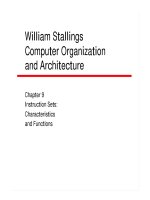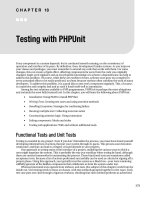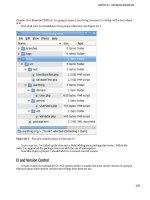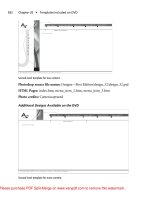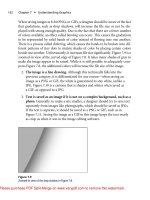OBJECT-ORIENTED PHP Concepts, Techniques, and Code- P4 docx
Bạn đang xem bản rút gọn của tài liệu. Xem và tải ngay bản đầy đủ của tài liệu tại đây (470.42 KB, 10 trang )
3
OBJECT-ORIENTED FEATURES
NEW TO PHP 5
PHP 3 was released in mid-1998. Some basic
object-oriented (OO) capabilities were
included, more or less as an afterthought,
to “provide new ways of accessing arrays.”
1
No
significant changes were made to the object model when
version 4 was released in mid-2000. The basics of object-
oriented programming (OOP) were there—you could
create a class and single inheritance was supported.
With the release of PHP 5 in 2004 there was plenty of room for improv-
ing PHP’s OO capabilities. At this point, Java, the most popular OO language
to date, had already been around for almost 10 years. Why did it take PHP so
long to become a full-fledged OO language? The short answer is because
PHP is principally a web development language and the pressures of web
development have only recently pushed it in this direction.
1
See Zeev Suraski, “Object-Oriented Evolution of PHP,” available at www.devx.com/webdev/
Article/10007/0/page/1. (Accessed March 27, 2006.)
OOPHP_02.book Page 11 Friday, May 5, 2006 2:25 PM
12 Chapter 3
Support for objects has been grafted onto the language—you can choose
to use objects or simply revert to procedural programming. That PHP is a
hybrid language should be viewed as something positive, not as a disadvantage.
There are some situations where you will simply want to insert a snippet
of PHP and other situations where you will want to make use of its OO
capabilities.
As I have already argued in Chapter 1, in some cases, an OO solution is
the only solution. PHP 5 recognizes this fact and incorporates a full-blown
object model, consolidating PHP’s position as the top server-side scripting
language.
Like Chapter 2, this will be a chapter of broad strokes. I’ll give a general
overview of how the object model has been improved, and then I’ll get into
the details using concrete examples in later chapters. I’ll also address the
issue of backward compatibility.
Access Modifiers
Chapter 2 identified access modifiers as an essential element of an OO lan-
guage. PHP 5 gives us everything we would expect in this area. In previous
versions of PHP there was no support for data protection, meaning that all
elements of a class were publicly accessible. This lack of access modifiers was
probably the biggest disincentive to using objects in PHP 4.
NOTE A notion closely related to data protection is information hiding. Access modifiers
make information hiding possible by exposing an interface (as defined in Chapter 2).
This is also referred to as encapsulation of an object.
Built-in Classes
Every OOP language comes with some built-in classes, and PHP is no excep-
tion. PHP 5 introduces the Standard PHP Library (SPL), which provides a
number of ready-made classes and interfaces. As of version 5.1, depending
upon how PHP is configured, all in all, there are well over 100 built-in classes
and interfaces—a healthy increase from the number available in version 5.0.
Having ready-made objects speeds up development, and native classes
written in C offer significant performance advantages. Even if these built-in
classes don’t do exactly what you want, they can easily be extended to suit
your needs.
NOTE There are far too many classes for us to deal with all of them in this book, and some are
still not very well documented. We’ll focus on the classes that are especially noteworthy.
Exceptions
All OOP languages support exceptions, which are the OO way of handling
errors. In order to use exceptions, we need the keywords
try, catch, and throw.
A try block encloses code that may cause an error. If an error occurs, it is
oophp03_02.fm Page 12 Tuesday, May 16, 2006 9:35 AM
Object-Oriented Features New to PHP 5 13
thrown and caught by a catch block. The advantage of exceptions over errors
is that exceptions can be handled centrally, making for much cleaner code.
Exceptions also significantly reduce the amount of error-trapping code you
need to write, which offers welcome relief from an uninspiring task. Also, hav-
ing a built-in exception class makes it very easy to create your own customized
exceptions through inheritance. (You’ll learn how to make the transition
from error trapping to exception handling in the section “Replacing Errors
with Exceptions” on page 79.)
Database Classes
Because PHP is all about building dynamic web pages, database support is all-
important. PHP 5 introduces the mysqli (MySQL Improved) extension with
support for the features of MySQL databases versions 4.1 and higher. You
can now use features such as prepared statements with MySQL, and you can
do so using the built-in OO interface. In fact, anything you can do procedur-
ally can also be done with this interface.
SQLite is a database engine that is incorporated directly into PHP. It is
not a general-purpose database like MySQL, but it is an ideal solution in
some situations, in many cases producing faster, leaner, and more versatile
applications. Again an entirely OO interface is provided.
PHP versions 5.1 and higher also bundle PHP Data Objects (PDO) with
the main PHP distribution. If you need to communicate with several differ-
ent database back ends, then this package is the ideal solution. PDO’s
common interface for different database systems is only made possible by
the new object model.
Given the importance of databases, we’ll deal with them extensively in
this book. We’ll develop a MySQL database class starting with Chapter 9.
In Chapter 15 we’ll look at SQLite, and in Chapter 16 we’ll discuss PDO.
Web Services
In PHP 5 all Extensible Markup Language (XML) support is provided by
the
libxml2 XML toolkit (www.xmlsoft.org). The underlying code for the
Simple API for XML (SAX) and for the Document Object Model (DOM)
has been rewritten, and DOM support has been brought in line with the
standard defined by the World Wide Web Consortium.
Unified treatment of XML under
libxml2 makes for a more efficient and
easily maintained implementation. This is particularly important because sup-
port for XML under PHP 4 is weak, and web services present many problems
that require an OO approach.
Under PHP 4, creating a SOAP client and reading an RSS feed are
challenging programming tasks that require creating your own classes or
making use of external classes such as
NuSOAP ( />projects/nusoap). There’s no such need in PHP 5. In Chapter 12, you’ll
see just how easy these tasks are using the built-in
SOAPClient class and
SimpleXMLElement. Again it’s the improved object model that makes this
possible.
OOPHP_02.book Page 13 Friday, May 5, 2006 2:25 PM
14 Chapter 3
Reflection Classes
The reflection classes included in PHP 5 provide ways to introspect objects
and reverse engineer code. The average web developer might be tempted
to ignore these classes, but Chapter 14 shows how useful they are for auto-
mating a task that most developers approach with little enthusiasm: the
creation of documentation.
Iterator
In addition to built-in classes, PHP 5 also offers built-in interfaces. Iterator is
the most important, as a number of classes and interfaces are derived from
this interface. I’ll show you how to use
Iterator in Chapter 10.
Backward Compatibility
Backward compatibility may be an issue if your code already uses objects.
PHP 5 introduces a number of new “magic” methods. Magic methods begin
with a double underscore, and this requires changing any user-defined meth-
ods or functions that use this naming convention. All of these methods will
be discussed, particularly in Chapter 13. The most important ones relate to
how objects are created and destroyed. The PHP 4 style of object creation
is still supported, but you are encouraged to use the new magic method
approach.
PHP 5 deprecates some existing object-related functions. For example,
is_a has been replaced by a new operator, instanceof (see Chapter 14). This
particular change won’t affect how your code runs under PHP 5. If you use a
deprecated function, you’ll see a warning if the error-reporting level is set to
E_STRICT (a useful technique for discovering where your code may need upgrad-
ing and discussed in more detail in Appendix A). In another example, the
get_parent_class, get_class, and get_class_methods functions now return a case-
sensitive result (though they don’t require a case-sensitive parameter), so if
you are using the returned result in a case-sensitive comparison you will have
to make changes.
Pass By Reference
The preceding examples of changes are relatively minor and fairly easy to
detect and upgrade. However, there is one change in particular that is of an
entirely different magnitude.
The major change to PHP in version 5 relating to OOP is usually summed
up by saying that objects are now passed by reference. This is true enough,
but don’t let this mask what’s really at issue: a change in the way that the
assignment operator works when used with objects.
Granted, the assignment operator is often invoked indirectly when
an object is passed to a function or method, but objects are now passed by
reference because of the implicit assignment. Prior to PHP 5, the default
behavior was to assign objects by value and pass them to functions by value.
OOPHP_02.book Page 14 Friday, May 5, 2006 2:25 PM
Object-Oriented Features New to PHP 5 15
This is perfectly acceptable behavior for primitives, but it incurs far too much
overhead with objects. Making a copy of a large object by passing it by value
can put strains on memory and in most cases, all that’s wanted is a reference
to the original object rather than a copy. Changing the function of the assign-
ment operator is a fairly significant change. In fact, the scripting engine
that underlies PHP, the Zend engine, was entirely rewritten for PHP 5.
NOTE In PHP 4 it’s possible to pass objects by reference using the reference operator (&), and in
fact it is good programming practice to do so. Needless to say, this use of the reference
operator becomes entirely superfluous after upgrading to PHP 5. We’ll discuss the
implications of this change in Chapter 13, in the section “__clone” on page 116.
Prognosis
The mere enumeration of the details of backward compatibility masks what
can be a highly charged issue. Whenever you change an established language,
there are competing interests. In many cases you’re damned if you do and
damned if you don’t. For example, retaining inconsistent function naming
conventions may be necessary to maintain backward compatibility, but you
may also be criticized for this very lack of consistency.
Of course, breaking backward compatibility means that some existing
code won’t function properly. In many circumstances it’s not easy to decide
where and when to break backward compatibility, but changing PHP to pass
objects by reference is a fairly defensible change despite any inconveniences.
The only thing you can be sure of is that any change will give rise to complaints
in some quarter. Certainly, having deprecated functions issue warnings is
one good way to give advance notice and let developers prepare for coming
changes.
Where to Go from Here
If you’ve bought this book and read this far you’re obviously interested in
OOP. If you know PHP already, then learning OO PHP will not be too
difficult. Given the relative simplicity of PHP’s object model, certainly less
effort is required than for a C programmer to learn C++. Nevertheless, mov-
ing to a new language or a new version of a language entails some cost in
terms of time and effort, especially if it has an impact on your existing code
libraries.
We’ve covered some of the backward compatibility issues as they relate to
OOP. Almost all procedural code will run with no changes under PHP 5. No
rewrites are required, and code does not need to be converted to an OO style.
Upgrading existing applications to take advantage of PHP 5 is a different
matter. In the case of some large applications, upgrading may require sig-
nificant effort. Many applications will benefit by being upgraded. If you’ve
ever tried to customize software such as phpBB (the popular open-source
forum), you know that the task would be much simpler if the application was
object-oriented. However, upgrading an application such as phpBB means
beginning again from scratch.
OOPHP_02.book Page 15 Friday, May 5, 2006 2:25 PM
16 Chapter 3
And there are other considerations besides code compatibility. After
learning the ins and outs of OOP with PHP 5, will you actually be able to
make use of it? Are there actually servers out there running PHP 5?
Adoption of PHP 5
As of this writing PHP 5 is hardly a bleeding-edge technology. It has been
available for more than a year, and there have been a number of bug fixes.
It’s a stable product. Where developers have control over web server config-
uration there’s no question that upgrading to PHP 5 will be beneficial. But
developers don’t always have a choice in this matter. In some situations
(where the developer has no control of the web host, for instance), the
decision to upgrade is in someone else’s hands.
PHP is a victim of its own success. The popularity and stability of PHP 4
have slowed the adoption of PHP 5. PHP 4 is a mature language that supports
many applications, open-source and otherwise. There’s naturally a reluctance
to rock the boat. For this reason the adoption of PHP 5 has been somewhat
slow, especially in shared hosting environments.
NOTE Other web hosting options have been much quicker to adopt PHP 5. The various virtual
private server (VPS) hosting options usually include PHP 5, as do dedicated hosts.
As a more secure and increasingly inexpensive hosting option, VPS is becoming much
more popular.
Compromise
Widespread adoption of PHP 5 will happen sooner or later, but this book
recognizes that developers may need, at least for a time, to continue writing
new applications that will run under PHP 4. For this reason, wherever possible,
a PHP 4 version of code has been provided in addition to the PHP 5 version.
In a sense, PHP 5 just formalizes what was already possible in PHP 4.
For instance, even though PHP 4 allows direct access to instance variables,
when creating a class in PHP 4 it makes sense to write accessor methods
for variables rather than setting or retrieving them directly. This requires a
disciplined approach, but it will yield code that not only runs under PHP 4
but also will be much easier to upgrade to PHP 5. Adding restrictive access
modifiers to variables will be a relatively simple task if accessor methods are
already in place. Writing code with the expectation of upgrading it will also
invariably mean writing better code.
That’s all the talk about OOP. In the remaining chapters you’re going
to do OOP.
OOPHP_02.book Page 16 Friday, May 5, 2006 2:25 PM
4
SHOW A LITTLE CLASS
Introductory books on object-oriented
programming (OOP) often use examples
of objects taken from the real world. For
example, you may be asked to imagine a “dog”
class. We are all familiar with dogs, of course, so it’s
relatively easy to describe a dog’s attributes. Most dogs have hair, four legs,
and a tail. A dog’s behavior is equally easy to describe. Dogs bark, jump, run,
roll over, dig, and, when passing fire hydrants . . .
I don’t mean to belittle this approach, but the objects that a web developer
deals with are not often objects “out there” that one can point to. They are
more likely to be conceptual rather than physical objects, and these are a
little harder to identify. Once identified, it is not easy to describe the objects’
attributes and behavior.
With that in mind, the class I propose you create is a list of files. (I know,
it’s not terribly exciting, but by keeping things simple, we can easily deal with
some of the basic concepts of OOP.) This class certainly won’t bark or jump,
but by the time we’re finished, it may roll over and do a few tricks.
OOPHP_02.book Page 17 Friday, May 5, 2006 2:25 PM
18 Chapter 4
NOTE We’ll use the syntax of PHP 4 to help ease into OOP. Starting with PHP 4 will also be
helpful for those who have already used OOP with PHP and want to upgrade their
code. I’ll show you how to do this in Chapter 5, and for convenience, I have also
included an appendix on this topic. (PHP 4 style code will run just fine under PHP 5
but will raise warnings if error reporting is set to
E_STRICT in the php.ini file. See
Appendix A for the OO configuration options of the
php.ini file.)
Design
OOP doesn’t eliminate the need for systems analysis. It’s easy to forget about
this step and to just start coding, especially when dealing with a fairly simple
task. However, a little forethought during the design stage will reap benefits
later on, so make sure you have a clear idea of what you want to do.
Defining the Problem
You often need to look at and manipulate the files in a specific directory, and
you often want to do this with directories that hold resources such as photos
or images,
.pdf files, or files that are compressed for downloading. Probably
the simplest approach, if your web server is Apache, is not to use any code at
all and simply put a
.htaccess file containing the directive Options +Indexes
into the appropriate directory.
By using a
.htaccess file, you can simply point your browser to the
directory that contains this file to see a list of its contents. Of course, if this
were your only goal, then building a class to mimic this functionality would
be entirely superfluous. However, you want to do a bit more than just list
files. You want to have control over the order in which they appear and the
file types that are listed, and you may also want to know the number of files.
Consider this fairly specific task: Suppose you have some cleanup work
that needs doing on directories that contain graphics. You need to remove
deadwood, but before you can do so, you need to view the images. Rather than
open each picture individually using an application such as Photoshop or
GIMP, you want to open all the files at once in your browser. Not only do you
want to see the image, you also want to note the filename of the image
in case you decide to remove it.
This is not a situation that requires an object-oriented (OO) solution. If
you are familiar with PHP, you’ve probably already formulated a rough algo-
rithm of how to solve this problem and determined which functions you
need to use.
If you are a programmer but not familiar with OOP, a procedural
approach will doubtless seem more natural and be easier to execute, especially
when approaching a straightforward problem. However, remember that we
are deliberately trying to keep things simple to begin with. Stick with me at
least until the end of the next chapter—you won’t be disappointed.
At this early stage, our simple class may not convince you of the utility of
OOP, but it will highlight the fact that OOP doesn’t do away with the need
for procedural programming. The logic required for OOP is every bit as pro-
cedural as the functions you’re used to creating and using.
oophp04_02.fm Page 18 Tuesday, May 16, 2006 9:37 AM
Show a Little Class 19
Not the Da Vinci Code
We’ll reproduce the code here and intersperse it with comments. (If you
would like an overview of the entire class, now would be a good time to
download the code for this chapter from the companion website at http://
objectorientedphp.com.)
In order to create a class, use the keyword
class and an appropriate name:
class DirectoryItems{ }
Braces enclose all the elements of a class, indicated by the ellipsis in the
preceding line of code.
We discussed the concept of a class in Chapters 2 and 3, but a bit of repeti-
tion here won’t be amiss. In its simplest form, a class can simply encapsulate a
variety of data types, the way a
struct does in C or a type in Visual Basic. This
class will encapsulate data types, but it will also contain functions or methods.
Like PHP’s built-in classes, we’ll use Java-style naming conventions for
the class name—not underscores, but uppercase letters for the start of each
word, otherwise known as studly caps. We’ll use the same naming convention
for files that contain class definitions. For example, the file that holds the
DirectoryItems class will be called DirectoryItems.php. This naming convention
is not a requirement but helps readily identify classes and their files.
The first statement inside the class is the declaration of the variable
$filearray. Upon declaration, this variable is initialized as an array.
var $filearray = array();
NOTE Notice the use of the var keyword. This syntax will be replaced in PHP 5, but here it
simply denotes an instance variable.
Any variable declared at this level, namely inside the braces that enclose
the class but outside any class function, is an instance variable or, as we might
also refer to it, a data member. (In most cases, classes contain more than one
data member, but one is sufficient for the moment.) Instance variables are
sometimes also referred to as properties. The placement of instance variables
outside of any function indicates that they have scope throughout the class.
Their visibility is not restricted to any specific function—they can be accessed
from anywhere within the class. You could say they are global to the class.
The Constructor
Next is a function that bears the same name as the class: the constructor.
Constructors are commonly used to initialize data members, and as in
Listing 4-1, filenames are added to the instance variable
$filearray.
function DirectoryItems( $directory){
$d = "";
if(is_dir($directory)){
$d = opendir($directory) or die("Couldn't open directory.");
OOPHP_02.book Page 19 Friday, May 5, 2006 2:25 PM
20 Chapter 4
while(false !== ($f=readdir($d))){
if(is_file("$directory/$f")){
$this->
filearray[] = $f;
}
}
closedir($d);
}else{
//error
die("Must pass in a directory.");
}
}
Listing 4-1: The
DirectoryItems constructor
Constructors are called whenever an object is created. In Listing 4-1, the
constructor accepts, as a parameter, a string variable of
a directory name.
Any files contained within this directory are added to
$filearray.
Referencing Instance Variables
The only remarkable thing about this code is the unusual syntax required to
refer to the instance variable. Variables such as
$d and $f, which are local to
the constructor, are referenced in the same way as any other PHP variable,
but when using
$filearray, we must precede it with $this->.
If you’re familiar with other OO languages such as C++ or Java, you’ll be
familiar with
$this, a “pseudo-variable” that identifies what follows as an
instance variable. However, unlike those other OO languages, use of
$this
when referring to an instance variable is not optional in PHP.
So much for the explanation of the syntax of the constructor. The
constructor actually performs a fairly simple and straightforward program-
ming task.
Wrapper Methods
The rest of the class is made up of a series of functions. Some of these func-
tions simply enclose or wrap existing array-related functions and are called
wrapper functions. These wrapper functions count or sort the list of filenames,
but instead of calling them functions, let’s use OO terminology and refer to
them as methods.
NOTE When declaring the methods of a class you are required to use the keyword function.
This can perhaps lead to some confusion. However, throughout we will use the term
method to distinguish between a regular function call and the calling a class function.
Again, following the studly caps naming convention, if a method name
is a compound word, use lowercase for the first word and uppercase for any
subsequent words. Listing 4-2 includes three methods that use built-in PHP
array functions.
OOPHP_02.book Page 20 Friday, May 5, 2006 2:25 PM

